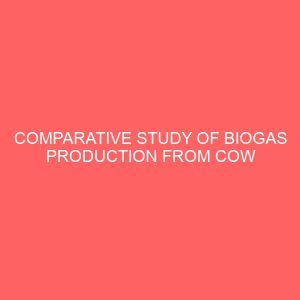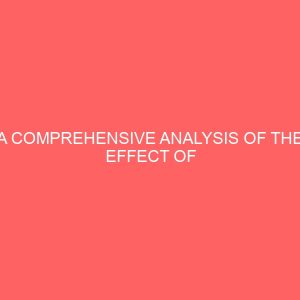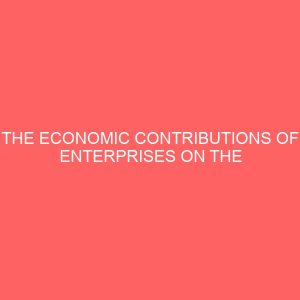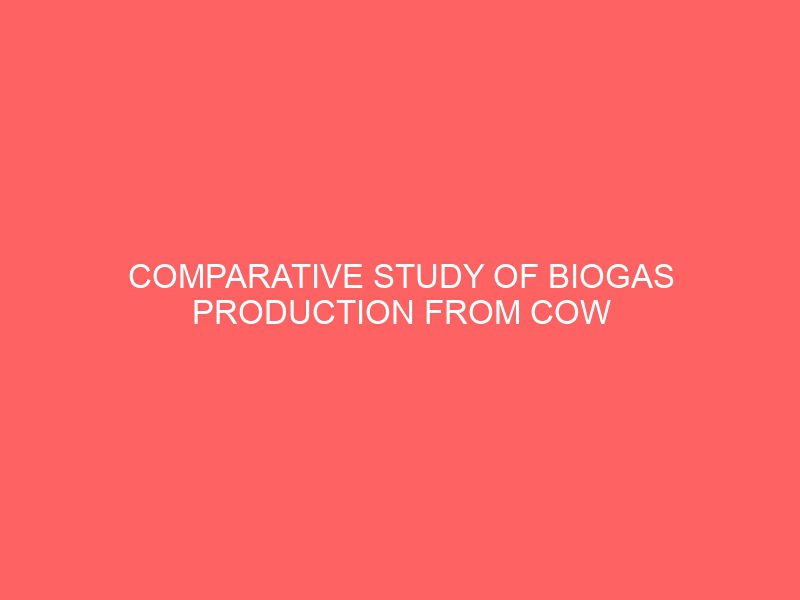Description
CHAPTER ONE
INTRODUCTION
1.1 BACKGROUND OF STUDY
This project is on Comparative study of biogas production from cow dung, chicken droppings and cymbopogon citratus as alternative energy sources in Nigeria. Environmental pollution is one of the most serious problems facing humanity and all other living things today. Economic growth and heavy consumption of natural resources are responsible for the global warming, acid rain and the destruction of the ozone layer (Thakur, 2006).
In Africa, water pollution and access to energy resources present challenges to human health, environmental health, and economic development. According to Mshandete and Parawira (2009), less than 10% of the population of 21 sub-Saharan African countries, have access to electricity. The need for alternative renewable energy sources from locally available resources cannot be over emphasized. Appropriate and economically feasible technologies that combine solid waste and wastewater treatment and energy production can simultaneously protect the surrounding water resources and enhance energy availability.
Abubakar (1990) noted that over the centuries, various sources of energy have been used by man in order to meet his basic life essentials. Man has utilized energy in modifying and manipulating land, water, plant and animals to obtain food, clothing and shelter.
Energy is a basic tool for development. Developing countries like Nigeria face added dilemmas regarding environmental protection due to their heavy dependency on biomass and fossil fuel. Adaramola and Oyewola, (2011) opined that Nigeria is endowed with huge resources of conventional energy resources (crude oil, tar sands, natural gas and coal) as well as reasonable amount of renewable energy resources (e.g. hydro, solar, wind and biomass).
The Organization of Petroleum Exporting Countries (OPEC) annual statistical bulletin 2009 in buttressing these facts revealed that Nigeria proven crude oil reserves and natural gas are 37.2 billion barrels and 5,292 trillion standard cubic meters, respectively. In addition, the estimated reserve of tar sands and proven reserves of coals are about 30 billion barrels of oil equivalent and 639 million tonnes (with inferred reserves of about 2.75 billion tonnes), respectively (Adaramola and Oyewola, 2011). These fossil fuel reserves are more than adequate to fuel much of Sub-Saharan Africa energy demand for several decades. Coal reserves are also substantial at 2.75 billion metric tonnes. Also, a large amount of renewable energy resources including hydro electricity, solar, wind and biomass energy are present. Hydro resources are estimated at 14,750 Megawatts. Solar radiation is estimated at 3.5-7.0 Kilowatt-hour/m2 per day, wind energy 2.0-4.0 m/s, wind energy at 150,000 Terra Joule per year and biomass at 144 million tonnes per year (Iwayemi, 2008).
Most of the developing nations are facing serious shortage of fuels, the most commonly used fuel being wood fuel. According to Nepalese 2001 population census, 65 percent of 4.17 million Nepalese households are using fuel wood for cooking purposes. As a result, 5.4 million tons of fuel wood is being burnt annually (Karki, et al, 2005). The case in Nigeria is not different.
The Social statistics presented by the Nigeria Bureau of Statistics (NBS) reveal that, Nigeria as at 2006 had a total of about 28,900,492 households. 79.6% of these households still depended on Wood fuel for cooking as at 2008 (NBS, 2009). In some states like Adamawa, Nassarawa, Zamfara, Sokoto etc, the percentage of households depending on wood fuel for cooking is over 90 (NBS, 2009). Even though sizeable proportions of urban and semi-urban dwellers use fuel wood, the majority of users of this fuel are rural dwellers, who constitute between 60-75% of the population in Nigeria (Ahmadu, 2009). With the recent hike in the pump price of Kerosene in Nigeria, the dependence on fuel wood for domestic cooking has significantly increased. The Figure 1.1 shows the percentage distribution of Nigerian households by the type of fuel used for cooking as at 2008.
Fig 1.1: Percentage Distributions of Households by Type of Fuel for Cooking as at 2008 (NBS, 2009)
The main challenge of the present world is to harness the energy source which is environment friendly and ecologically balanced. This need has forced the world to search for other alternate source of energy. But unfortunately the new alternative energy sources like the solar, hydro, wind etc. require huge economical investment and technical power to operate, which seem to be very difficult for the developing countries like Nigeria. In the present moment biogas energy can be one and only reliable, easily available and economically feasible source of alternative and renewable source which can be managed by locally available sources and simple technology for these rural villages.
A biogas plant or latrine when successful is an appropriate and sustainable method to deal with human or animal waste. This system produces two extremely useful products from the waste: biogas and slurry. Using biogas for cooking and lighting reduces the strain on the environment by decreasing the use of biomass and the production of green house gases (as methane that is produced normally from manure is now captured and used). The biogas system also provides a barrier protecting ground water from contamination from untreated waste (Ocwieja, 2010).
To save the environment from further deterioration and also supplement the energy needs of the rural populace, a strategy incorporating local resources and new technology as biogas technology can be effectively utilized (Ahmadu, 2009). More so, with the declining quantity of fossil fuels it is critical today to focus on sustained economic use of existing limited resources and on identifying new technologies and renewable resources, e.g., biomass, for future energy supply (Deublein and Steinhauser, 2008).
Biogas systems are highly friendly to the environment. In fact, the contribution of a methane molecule (CH4) to the greenhouse effect is 21 times greater than that of a carbon dioxide molecule. Therefore burning methane, even though producing CO2, reduces its impact on the environment. The digested slurry coming out of the plant is used for organic fertilizer production. Besides, bio digesters can be used to treat municipal waste and generate electricity. One of the options to utilize biogas is to produce electricity using a gas engine or gas turbine (Karki et al, 2005).
As well as being better for the climate, Anaerobic Digestion has other benefits over traditional waste management technologies. Plants can be small and low rise so may be situated in towns, reducing haulage distances and associated traffic pollutants. They are faster to build and to get planning permission for, as proposals are more acceptable to local residents than with other technologies. Anaerobic Digestion also produces less air and solid emissions than incineration, landfill and pyrolysis and gasification (Friends of the earth, 2007).
The process of fermentation in bio digesters results in transformation of organically bound carbon into gaseous carbon dioxide and methane. The anaerobic environment and extended retention time also inhibit the growth of most pathogenic organisms and prevent the survival of intestinal parasites. It is therefore to be expected that both the chemical and biological parameters of livestock excreta will be improved upon by passage through biodigesters (www.fao.org).
The prospect of this technology is bright in developing countries like Nigeria. This is because Nigeria is an energy resource rich country in terms of both fossil fuels (such as crude oil, natural gas, coal), and renewable energy resources like solar, wind and biomass (Mshandete and Parawira, 2009). The technology can be utilized to provide energy for households, rural communities, farms and industries.
Biogas is a flammable gas produced by the biological fermentation of organic materials such as agricultural waste, manure and industrial effluents in an anaerobic (oxygen deficient) environment to produce methane, carbon-dioxide and traces of hydrogen sulphide, (Ahmadu, 2009).
Fig. 1.2: Biogas from Organic Wastes(Igboro, 2011).
1.2 STATEMENT OF THE RESEARCH PROBLEM
Energy consumption in Nigeria has been increasing on a relatively high rate. On a global scale, Iwayemi (2008) opined that the Nigerian energy industry is probably one of the most inefficient in meeting the needs of its customers. This is most evident in the persistent disequilibrium in the markets for electricity and petroleum products, especially kerosene and diesel. The dismal energy service provision has adversely affected living standards of the population and exacerbated income and energy poverty in an economy where the majority of the people live on less than $2 a day.
Energy in form of electricity has been identified as an important element in achieving national development goals. It is an established fact that its availability in terms of sufficient quality and quantity at affordable prices will stimulate economic growth yet, the recent facts on the state of electricity in the country revealed that Nigeria currently generates an average of 4,500 Megawatts against a demand in excess of 25,000 MW (http://www.enownow.com/news). It therefore implies that the nation is meeting only 18% of her electricity need which is grossly inadequate.
The abundant hydrocarbon natural resource (crude oil and natural gas) in Nigeria is the mainstay of over 80% of revenues to the nation. This has not served as a catalyst for economic growth neither has it served as the major source of energy in the mix of energy supplies (Machunga-Disu and Machunga-Disu, 2012). Furthermore, the ever increasing prices of petroleum products globally, has made kerosene, which is the most commonly used fuel for cooking and lighting unaffordable to many, especially the rural dwellers, (Ahmadu, 2009). This therefore moves a larger percentage of the populace to seek solutions to their energy needs from other sources which in most cases are detrimental to the environment. For instance, there was a 5.5% increase in the dependence on wood fuel for cooking between 2007 and 2008 (NBS, 2009). More so, 79.6% of the households depend on wood fuel for their cooking while kerosene, coal, gas and electricity comes behind from distant 18.5%, 1.1%, 0.6% and 0.2% respectively (NBS, 2009).
Poorly managed forests have to shoulder immense burden to meet the increasing demand for energy caused by both the rising population and the lack of development alternative energy resources. Wood fuel has been and still is the major source of fuel daily used by rural mass in Nigeria. This total dependence on wood fuel as the source of energy for cooking has resulted in deterioration of the quality and quantity of forests and has posed a serious threat in maintaining ecological balance, thereby manifesting various problems like deforestation, flood, Global warming, soil erosion , landslides, climate change etc. Thus, an alternative energy source that would be affordable and environmentally friendly becomes necessary if the green forest must be preserved. Furthermore, there exist abundant evidence that climate change is a severe threat to socio-economic development and can substantially affect a nation’s GDP, as it affects water, forest, sanitation, food security, industrial development, housing, energy, health and the very air we breathe (Machunga-Disu and Machunga-Disu, 2012). Thus, development of biogas technology is a suitable alternative energy source that would be affordable and environmentally friendly that would help preserve the green forest thus achieving the 7th mandate of the Millennium Development Goal on environmental sustainability.
Moreover, governments and industries are constantly on the lookout for technologies that will allow for more efficient and cost-effective waste treatment. In addition to meeting the dire need for waste treatment options to enhance a clean environment, alternative processing technologies, such as anaerobic digestion, offer some potential for recovery of value from organic wastes (i.e., waste to wealth) by producing biogas and soil-conditioning composts. Furthermore, with the enormous cattle population especially in the northern part of the country, millions of tonnes of dung released daily emit a lot of methane gas when exposed to the atmosphere, which is 320 times more harmful to human health than carbon dioxide (Thakur, 2006). In addition Cymbopogon citratus (Lemon grass) is a well known medicinal plant as due to its citral content (Tajidin et al., 2012). After it is boiled for medicinal purpose and the citral content is extracted, the remains of the grass become waste and could constitute nuisance to the environment. There is therefore an urgent need for development of adequate means to recycle these wastes and generate wealth from them. Thus biogas technology could be an appropriate means for recycling organic waste thereby achieving the goal one of the Millennium Development Goals (MDGs) of eradicating extreme poverty (UN, 2005) via waste to wealth initiative. Thus the organic waste becomes a channel for wealth creation as they are harnessed as feed materials for the production of biogas as well as bio fertilizers that would accrue from the digestate. It is for these reasons that researches like the present one are desirable to chart a course for sustainable energy production and utilization while a cleaner and safer environment is enhanced.
1.3 JUSTIFICATION OF STUDY
Kerosene and other oil based sources of fuel are scarce and costly to be easily available for small marginal and medium farmers residing in rural areas. Furthermore, frequent alarming hike in prices of imported oil and chemical fertilizer have serious economic threat to the rural poor. In this context, to reach the self-sufficiency in energy and fertilizer and to minimize the pressure on traditional biomass fuel, biogas technology has been the best alternative energy solution, which could be achieved through the active mobilization and economic utilization of local indigenous resources available in the country.
It has been estimated that Nigeria produces about 227,500 tonnes of fresh animal waste daily. Since 1 kg of fresh animal waste produce about 0.03 m3 biogas, then Nigeria can potentially produce about 6.8 million m3 of biogas every day from animal waste only (Mshandete and Parawira , 2009). A recent study that assessed Nigeria’s biogas potentials (minimum value) from solid waste and livestock excrements revealed that in 1999, Nigeria’s biogas potential represents a total of 1.382×109 m3 of biogas/year or an annual equivalent of 4.81 million barrels of crude oil (Ojolo et al, 2007).
In addition, 20 kg of municipal solid waste (MSW) per capita has been estimated to be generated in the country annually (Mshandete and Parawira , 2009). By the 2005 census figure of about 140.4 million inhabitants, the total generated MSW will be at least 2.81 million tonnes every year. With increasing urbanization and industrialization, the annual MSW generated will continue to increase.
Biogas production may therefore be a profitable means of reducing or even eliminating the menace and nuisance of urban wastes in many cities in Nigeria.
Moreover, the methane content of biogas depends to a significant extent on the nature of the feed material with succulent grass having the highest value of about 70% (Sasse, 1988).
Most of the previous biogas researches in Nigeria used animal dung and kitchen wastes as feedstock substrates while the use of succulent plants for biogas production have been limited to water lettuce, water hyacinth, cassava leaves and Eupatorium odoratum (Akinbami et al., 1996, 2001; Okagbue, 1988; Ubalua, 2008, Odeyemi 1981). These plants are mostly found in the riverine regions of the country. There is no record of any research on the potential of Cymbopogon citratus (Lemon grass) which is more widely distributed in Nigeria than the other plants previously tested. Cymbopogon citratus popularly known as
Lemon grass belong to the family Grami-neae and the genus Cymbopogon (Akhila, 2012). It is native of the warm temperate and tropical regions of the old world. Lemon grass can tolerate a wide range of soils and climatic conditions (Sugumaran et al., 2005). Since Cymbopogon citratus is not as widely available as the animal wastes, co-digesting it with animal dung would provide a good synergy for improved gas production. Thus, the animal waste provides the high volume while the quality of the resultant gas is optimized by the Cymbopogon citratus.
With the rapidly increasing waste generation threatening to prevent humans from carrying out their activities for lack of space, the society is therefore faced with the choice to either allow this biomass waste to continue polluting the environment; methane and carbon dioxide production, to continue to increase global warming or boldly take the initiative of converting the biomass into alternative energy (Igboro, 2011).
The study therefore explores means of converting this and other organic waste to energy as a very attractive option for adequate treatment that will enhance environmental sustainability, which is one of the eight Millennium Development Goals set by the UN. It is therefore necessary in moving towards a sustainable energy society. While converting waste into energy is especially appealing conceptually, there is still much to be done before the technology becomes commonplace. Also, the research is necessary in order to optimize the technologies, build confidence in their effectiveness, and prepare them for the market (Igboro, 2011). This will require significant efforts in outreach. Policy makers, farmers, engineers, the business community and the rural community need to know about issues of sustainable development which confront us and biogas utilization would just be the panacea for our energy problem.
1.4 AIM AND OBJECTIVES OF STUDY
The research aims at the comparative production and utilization of biogas for cooking, using cow dung, chicken droppings, Cymbopogon citratus (lemon grass) as well as the respective co-digestion of cow dung and chicken droppings with Cymbopogon citratus (lemon grass).
The study has the following specific objectives:
- To design and construct biogas digester plants that would operate under existing weather conditions; ii. To utilize the biogas digesters so constructed for the digestion of cow dung, chicken droppings and lemon grass;
- optimization of the anaerobic digestion of cow dung and chicken droppings for maximum energy production via co digestion of each with lemon grass;
- To establish the technical performance of the anaerobic digestion of cow dung, chicken droppings and lemon grass as well as their co-digestions with lemon grass respectively as biomass feed material.
- To study and determine the most feasible local environmental conditions to optimally operate the developed biogas facilities.
- To upgrade the biogas via scrubbing of impurities and test for the heating efficiency before and after scrubbing.
1.5 SCOPE OF THE STUDY
This study is limited to cow dung from Zango abattoir, chicken droppings from the poultry section (deep litter) in the National Animal Production Research Institute (NAPRI), Shika, Zaria as well as Cymbopogon citratus (Lemon grass) sourced locally from Area BZ staff quarters, Ahmadu Bello University main campus, Samaru-Zaria.








Get free iPhone 15: http://momentumsecurityservices.uk/upload/go.php hs=90e84876c1d95f0771d56ddcd4bf7ce2* –